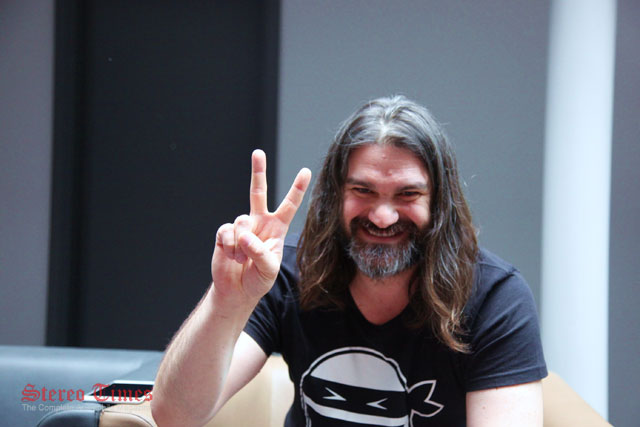High End 2017: CP Report – Sonic Impressions Page 5


Finally, I was able to catch a live jazz act during the High End show! Catching the Fred Hersch Trio during the High End -which featured Hersch (piano), Eric McPherson (drums) and John Hébert (bass), was like putting a cherry topping on my ice-cream cone! YES, this was the very same John Hébert who walked the hallowed halls of the High End show with me earlier that day. Now, I got the opportunity to see him in action once again. I invited lots of folks during the show including my friend and fellow audio enthusiast/Laufer Teknik tech-man, Buffer Ergmann, Jr. Held on the outskirts of Munich, in small Bavarian suburb of Oberhaching, at a large and acoustically-sound and well-maintained concert hall. I would say that both Buffer and I were surprised at how good this trio’s performance sounded in this space; particularly from our seats which were nearer the back of this rather nice sized space. Despite the fact we were so far back from the stage, we quietly spoke about how easy it was to hear even the most delicate touch from Fred’s piano or accent off the cymbals. John’s play was also very subtle when needed and forceful, yet polite in certain well-deserved spots. Never fat, wooly or ill-defined. Looking up at the ceiling and side-walls revealed little as to how this space sounded so neutral: neither dead or alive. In the end, this acoustically excellent concert-hall had both Buffer and I brimming with approval. [FYI, the Stillpoints footer for John’s bass was a bust as it didn’t fit correctly. Paul Wakeen says they’re working on making a specialized clamp for John’s upright so stay tuned. I’m sure John will be delighted to share on his experiences with this most unusual tweak.]





Extreme Audio’s Aldo Zaninello is inextricably tied to my first-time encounter with the Italian-made electronics manufacturer Grandinote. The above photos show my various one-on-one listening sessions with the Grandinote electronics driving the mighty Leonardo planar-ribbon loudspeakers which, by the way, also are Italian-made. And in each case, I was so smitten by the performance of these mighty planar transducers – which reproduced levels of dynamics I had not previously heard from a planar source – I paid very little attention to – and gave little credit to – the electronics. BIG MISTAKE.
Well-aware that planars are notoriously inefficient yet in each encounter noted above, they sounded ever-so effortless, open and detailed, driven by this mere 37-watt Class A Grandinote amplifier! Of course, this remarkable level of reproduction only caused me to applaud the marvelous sounding Leonardos that much more. It was in the Miles Davis, Kind of Blue photo above and while on a vacation in Italy where I visited the Leonardo factory and where I learned the facts. Through a side-by-side amplifier shoot-out that featured the Grandinote Shinai integrated against a very popular pure Class A tube amplifier (that shall remain nameless here because it is still an excellent sounding design except when compared to the Grandinote attempting to drive a very difficult load like a planar-ribbon). Aldo Zaninello demonstrated for me, without perhaps realizing, precisely why the Grandinote design is so special: for over two decades I believed that a well-designed tube amplifier would outperform a well-designed world-class solid-state device whenever paired with a planar loudspeaker. Granted, some famous solid-state devices from back in the day like Krell and Levinson could provide better wallop, slightly more bass impact and control than their tube counterparts. Ultimately however, solid-state just simply never sounded quite as real and always suffered when it came to depth, dimensionality and musicality. You can only imagine the look on my face when Aldo switched from this well-known tube amplifier to that same 37 watt Grandinote which then proceeded to outperform it, not only in the areas of dynamic impact, and bass control but also with regard to depth, dimensionality and musicality! “Are you f*&!ing kidding me? What the hell is going on here Aldo?” I exclaimed. He just hunched his shoulders and smiled. Didn’t say a word. That’s when it all finally made sense to me that this little somewhat oddly shaped and mundane looking Italian amplifier was GREATLY responsible for what I had admired about the Leonardo loudspeaker. Consider this a lesson learned.

So much so, when Grandinote designer Max Magri invited me to audition his new prototype Mach 4 loudspeaker, Shinai integrated and Volti music server at a remote location on the outskirts during High End 2017, of course, I leaped at the opportunity. It was probably late Saturday afternoon when first arrived at the Golden Ball apartments located about 20 miles south of the High End show. And it was in the lobby where I was greeted with a firm handshake and a big hug by this young, hippy looking gentlemen who just so happens to be Grandinote’s chief designer Max Magri (above photo). “Oello Clementee, ‘cuse my bada English” Max laments. “No problem, it’s better than my Italian!” I responded. It was then that we had a cup of coffee and some small talk before heading up to his second floor suite.



This would mark my first time hearing an all Grandinote setup that featured two of their newest products in the Mach 4 loudspeakers ($16k), Shinai integrated ($13,200k) and Volti music server ($11,500). And upon first glance, I have to admit I was underwhelmed. I mean c’mon, after walking the hallowed halls of the High End show where some of the most gorgeous high-end audio products in the world were on display. You can go from room to room and actually listen to a half dozen loudspeakers that stood 8ft tall and cost hundreds of thousands of dollars each! Crazy…Okay…”So, what do we have here in these little jokers?” I mumbled under my breath.


Looks are most certainly deceiving. The only thing I understood that Max mentioned again and again was “there is no crossover in the Mach 4 Clementee because the drivers have been specially modified by me and the cabinet is all-aluminum!”

Equipped with my favorite recordings on a USB drive, I kindly asked Max to load this into the Volti music server. Upon doing so, he handed me the touchscreen monitor with all my favorites readied right at my finger tips.

I sat and listened. And listened. And listened…. The only thing that kept coming back to me was the word SCARY. Not sure if I have heard a loudspeaker, in the Mach 4’s price category, as dynamically astute, tonally accurate and as invisible sounding. I’m convinced the Grandinote Mach 4’s will flat out embarress loudspeakers a few times their asking price simply because they’re as pure sounding as the driven snow, compliments of a crossoverless design. Many designers boast the most expensive and sophisticated crossover parts but I doubt, even if made of the purist materials available, they could outperfom nothing. And nothing in the signal path represents a new sense of information that poured through this listening space and in all honesty surprised the hell out of me. I sat there going through more and more songs wondering how the Mach 4’s continued to allow the music through in a way that was horn-like dynamically and especially with regard to speed. Is Max Magri THIS GOOD at making loudspeakers?
There are few designers that I know of who are talented in more than one discipline in our beloved hobby. Mark Porzilli, serves as a perfect example. Here’s a guy who basically built the first and finest headphone amplifier in the Melos Sha Gold back in the early ’90s. Yet he also designed the legendary line-source loudspeakers, the Nearfield Acoustics’ Pipedreams more than a decade later. Porzilli is also the brains behind the Laufer Teknik Memory Player. I know many who dabble with the idea but few can actually design more than one SOTA (state of the art) product in a lifetime.
For example, Dan D’Agostino made great sounding loudspeakers but he’ll always be better known for his big and beefy amplifiers. Andy Payor of Rockport makes some of the most impressive and luxurious sounding turntables in the world, yet he’s far better known for his loudspeakers. So, even when these super talented designers do succeed at making more than one product, it’s more difficult ascending beyond what they’ve become famous for. What gives me hope for Max Magri obtaining a well-known status is the price/performance ratio of the Mach 4 as it retails for only $16k. Besides, his Shinai integrated and Volti music server now have the perfect playmate when someone wants to audition either of these products. The one thing I’ve learned is that Max Magri is as legitimate a designer as I have met. His products are state of the art quality without the price tag and that’s such a relief to anyone seeking the absolute best available without having to spend more than $40k. Unbelieveable, but true.
As I write this, I have in my possession (in my dining room) the big Grandinote Demone monoblocks and Divina preamp driving a pair of Bache Audio 002AB loudspeakers – which by the way also boast a crossoverless wideband driver. The sound is so wide-open and natural that it really is perhaps the best sounding system that I have had thus far in my downstairs rig (yes, the Sound Kaos were equally as wonderful sounding throughout the mid-bass to upper frequencies but really proved no match in the bass region). I’ve a review in the works so stay tuned!
Until the next time we meet!

clement perry
Stereo Times Masthead
Publisher/Founder
Clement Perry
Editor
Dave Thomas
Senior Editors
Frank Alles, Mike Girardi, Russell Lichter, Terry London, Moreno Mitchell, Paul Szabady, Bill Wells, Mike Wright, and Stephen Yan,
Current Contributors
David Abramson, Tim Barrall, Dave Allison, Ron Cook, Lewis Dardick, John Hoffman, Dan Secula, Don Shaulis, Greg Simmons, Eric Teh, Greg Voth, Richard Willie, Ed Van Winkle, and Rob Dockery
Site Management Clement Perry
Ad Designer: Martin Perry






Be the first to comment on: High End 2017: CP Report – Sonic Impressions Page 5